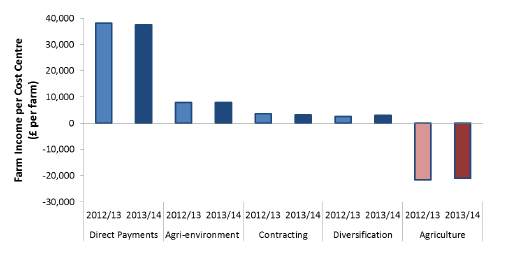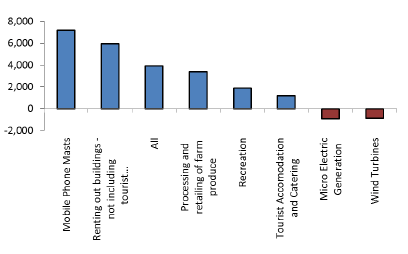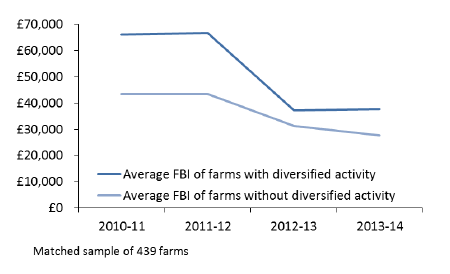Scottish farm business income: annual estimates 2013-2014
This publication contains farm business level estimates of average incomes for the accounting year 2013-14, relating to the 2013 crop year. For the most recent data, visit the Scottish farm business income (FBI) collection page below.
This document is part of a collection
3. Comparison of Profitability
3.1 Cost centres (Table 7)
The purpose of cost centre analysis is to identify the contribution to the overall business profit or loss of different sources of income within the business. All inputs and outputs have been counted against one of five cost centres: agricultural; agri-environment (land management to support environmental objectives); diversification; agricultural contracting (off-farm use of farm business resources); and income from the direct payments scheme (costs could be incurred against this centre if, for example, accountants are hired to manage claims).
Figure 5 below shows the overall average income from each cost centre in 2012-13 and 2013-14. In both years, losses were accumulated against farming activity (the agricultural cost centre).
In 2013-14, losses made against agricultural farming activities were partly off-set by income generated through diversification, contracting and agri-environment activities, though the profitability of the average Scottish farm business is heavily reliant on income from the Direct Payment Schemes. In 2013-14, losses from agricultural farming activities were comparable to that seen in 2012-13 (-£21,000 on average), although the average farm business still made a loss even after accounting for diversification (£3,000), contracting (£3,000) and agri-environment activities (£8,000), indicating that farm businesses were reliant on subsidies (£38,000) to make a profit.
Figure 5: Farm Business Income by cost centre

This shows that while farm businesses are generating profits, agricultural activities on their own are generating losses and suggests that farm businesses are heavily reliant on subsidies.
In 2013-14 the average income to Scottish farm businesses from direct payments was £38,000, down two per cent on the previous year (due to a less favourable exchange rate). There was little change in the value derived from agri-environment schemes and contracting in the latest year, with these activities generating an average of £8,000 and £3,000 respectively. In 2013-14, diversified activities generated around £3,000 on average, as described below, though there was not the apparent premium in incomes for farms engaged in diversified activities that was seen in 2010-12: this is expected to be due to high depreciation rates associated with early years of investment in renewables.
3.2 Diversified activities (Tables 8, 9)
Half of all farms in 2013-14 received additional income from diversified activities. Figure 6 shows the main activities undertaken and the average income from each. Of farms engaged in diversified activity the overall average income from such activities was £4,000. Almost half (43 per cent) of diversified activities were renting out buildings for uses (other than tourist accommodation), but it was income from land used for mobile phone masts that generated the greatest margins from diversification.
Figure 6: Average income from diversified activities: 2013-14

Micro electric generation and wind turbines were the only activities which made an average loss, although the losses seen were not as high as in 2012-13. There are relatively high start-up costs compared to initial output as well as high depreciation costs associated with these activities.
Figure 7 shows, from a matched sample (comparing the same farms each year), the average FBI of those farms engaged in any diversified activity and those with no diversified activities. Diversification is only assessed over a four year period to allow the sample size to remain as large as possible.
Figure 7: Comparison of average income of farms with and without diversified activities

Average income was greater for farms engaged in diversified activities at £38,000, which has remained relatively unchanged to that seen in 2012-13, while the average income on non-diversified farms has fallen by around £3,000. The difference between this and farms with no diversified activity is around £10,000.
The unmatched sample shows that income from micro electric generation and wind turbines have both seen large increases over the last year even though the activities still generated an overall loss. Processing and retailing of farm produce has seen a drop in income over the last year, with the renting out of buildings for agricultural purposes seeing a rise in income although not quite returning to the level seen in 2011-12.
Contact
Email: agric.stats@gov.scot
There is a problem
Thanks for your feedback